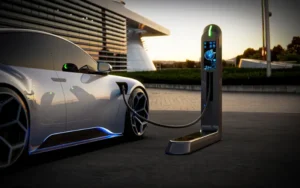
Smart motorcycle helmets are essential for safety, but they can be even more beneficial when they are equipped with smart technology. Smart helmets have a variety of features that can help riders stay safe and connected while on the road.
Table of Contents
What is a Smart Motorcycle Helmet?
A smart helmet for motorcycles, also known as a smart motorcycle helmet, is a modern safety accessory designed to provide additional features and functionalities beyond the basic protection offered by traditional helmets. These helmets integrate technology to enhance the safety, communication, and overall experience of motorcyclists.
Who are the target users of smart helmets?
Smart helmets are designed for all types of motorcyclists, from commuters to long-distance touring riders. They are especially beneficial for riders who want to stay connected and safe while on the road.
Features of smart helmet
There are many features you will find in smart motorcycle helmets. They vary depending on the brand and model of the smart helmet. Here are some essential and common features that should be found in smart motorcycle helmets:
Heads-up Display (HUD): Some smart helmets come with an integrated heads-up display that provides information like navigation directions, speed, and other relevant data directly in the rider’s field of view, often through a transparent visor or a small screen.
Bluetooth Connectivity: Smart helmets often have built-in Bluetooth connectivity, enabling riders to connect their smartphones for hands-free calling, music streaming, and communication with other riders in a group using intercom systems.
Integrated Camera: Many smart helmets have an integrated camera that allows riders to record their journeys, capture photos, or even livestream their rides.
Communication Systems: These helmets can feature intercom systems that enable riders to communicate with passengers or other riders in their group. Some models also support voice commands.
Noise Reduction: Some smart helmets incorporate active noise-cancellation technology to reduce wind and road noise, providing a quieter and more comfortable riding experience.
Safety Features: Smart helmets may include safety features such as built-in sensors that can detect accidents and automatically send alerts or notifications to emergency contacts or services.
GPS Navigation: Built-in GPS or integration with smartphone apps can provide turn-by-turn navigation and real-time location information.
Weather Information: Some smart helmets can display weather forecasts and real-time weather conditions to help riders make informed decisions during their ride.
Health and Performance Monitoring: Some advanced models have sensors to monitor the rider’s vital signs, track fatigue levels, or provide other health-related information.
Augmented Reality (AR): In some cases, smart helmets can offer augmented reality overlays, displaying relevant information on the visor, such as speed limits, points of interest, and other data.
Emergency Services Integration: Certain smart helmets can connect to emergency services in case of an accident or other emergencies.
AI in Smart Motorcycle Helmet
Some smart motorcycle helmets had begun to incorporate basic artificial intelligence (AI) capabilities, particularly in the context of voice recognition and control. These AI features were used to enhance voice commands, allowing riders to interact with their helmet’s integrated systems more naturally.
AI integration in smart motorcycle helmets can include:
Voice Commands: AI-powered voice recognition allows riders to control various functions of the helmet, such as making calls, playing music, or accessing navigation, using voice commands. The AI learns and adapts to the rider’s voice for improved accuracy over time.
Natural Language Processing (NLP): Some smart helmets employ NLP algorithms to understand and respond to more complex, context-aware voice commands and queries.
Noise Cancellation: Advanced AI algorithms can be used to enhance noise-cancellation capabilities, reducing wind and road noise to improve the overall riding experience.
Adaptive Features: AI can help the helmet adapt to changing conditions, such as adjusting noise-cancellation settings based on the environment or providing real-time feedback and alerts for safety.
Advantages of using the smart helmet
There are many advantages to using smart helmets, including:
Increased safety
Smart helmets can help to prevent accidents by providing riders with information about their surroundings and by alerting them to potential hazards.
Improved convenience
Smart helmets make it easier for riders to stay connected and entertained while they are riding. They can also help riders to navigate their way around unfamiliar areas.
Enhanced communication
Smart helmets allow riders to communicate with each other or with emergency services in the event of an accident.
More fun
Smart helmets can make riding more enjoyable by providing riders with entertainment and information.
Reduced distractions
Smart helmets can help to reduce distractions by allowing riders to control their phones or music without taking their hands off the handlebars.
Improved situational awareness
Smart helmets can help riders to improve their situational awareness by providing them with information about their surroundings.
Personalized experience
Smart helmets can be customized to the rider’s individual needs and preferences.
Disadvantages of using the smart helmet
The main disadvantages of using smart helmets are:
High price
Smart helmets are typically more expensive than traditional helmets.
Battery life
The battery life of smart helmets can be limited, depending on the features that are used.
Privacy concerns
Some people may be concerned about the privacy implications of using a helmet that is equipped with cameras and sensors.
Technical issues
Smart helmets are a relatively new technology, so there may be some technical issues that need to be worked out.
Factors to consider when choosing a smart helmet
When choosing a smart helmet, there are a few factors to consider, including:
- Features: The features that are most important to you.
- Price: The budget that you have available.
- Battery life: The battery life of the helmet.
- Comfort: The helmet should be comfortable to wear.
- Safety rating: The helmet should have a good safety rating.
- Brand: There are a number of reputable brands that sell smart helmets, so it is important to do your research and choose a brand that you trust.
Maintenance and care of smart helmets
Smart helmets should be maintained and cared for in the same way as traditional helmets. This includes:
- Inspecting the helmet regularly for damage.
- Wearing the helmet correctly.
- Storing the helmet in a cool, dry place.
- Cleaning the helmet regularly.
The future of smart helmets
The future of smart helmets is bright. As technology continues to advance, we can expect to see even more features and capabilities being added to smart helmets. Some of the potential future features of smart helmets include:
Advanced crash detection
Smart helmets could be equipped with sensors that can detect the severity of a crash and automatically send an emergency signal.
Head injury monitoring
Smart helmets could be equipped with sensors that can monitor the rider’s head for signs of injury.
Blind spot elimination
Smart helmets could be equipped with cameras that can provide the rider with a 360-degree view of their surroundings.
Self-driving capabilities
Smart helmets could eventually be equipped with technology that allows them to drive the motorcycle autonomously.
The Impact of Smart Helmets on the Motorcycle Industry
Smart helmets have the potential to have a major impact on the motorcycle industry. They could make motorcycles safer, more convenient, and more enjoyable to ride. As a result, we can expect to see increasing demand for smart helmets in the years to come.
If you are a motorcyclist, I encourage you to consider investing in a smart motorcycle helmet. It can help you stay safe, connected, and entertained while you are riding. They are the future of motorcycle safety, and they are worth the investment.








